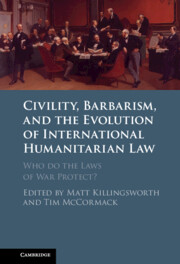 Civility, Barbarism and the Evolution of International Humanitarian Law
Civility, Barbarism and the Evolution of International Humanitarian Law How Are Female Child Soldiers Protected by the Laws of War?
Published online by Cambridge University Press: 11 January 2024
This chapter explores the protections afforded under the laws of war to young women and girls who, over the course of a single conflict, may occupy the roles of a child, a civilian, a combatant, a killer, a victim of sexual violence, and/or a mother. But rather than exploring this question into relation to women and girls as a homogenous group, it focuses on one young woman in one conflict, the so-called Second Congo War. Drawing on testimony provided by this witness during the Ntaganda case at the International Criminal Court (ICC), the chapter presents a critical view on the role of law in war. It observes that even with advances in legal protections for women and girls, as demonstrated by this important ICC case, in practical terms these actors often have no one to protect them but themselves.
To save this book to your Kindle, first ensure no-reply@cambridge.org is added to your Approved Personal Document E-mail List under your Personal Document Settings on the Manage Your Content and Devices page of your Amazon account. Then enter the ‘name’ part of your Kindle email address below. Find out more about saving to your Kindle.
Note you can select to save to either the @free.kindle.com or @kindle.com variations. ‘@free.kindle.com’ emails are free but can only be saved to your device when it is connected to wi-fi. ‘@kindle.com’ emails can be delivered even when you are not connected to wi-fi, but note that service fees apply.
Find out more about the Kindle Personal Document Service.
To save content items to your account, please confirm that you agree to abide by our usage policies. If this is the first time you use this feature, you will be asked to authorise Cambridge Core to connect with your account. Find out more about saving content to Dropbox.
To save content items to your account, please confirm that you agree to abide by our usage policies. If this is the first time you use this feature, you will be asked to authorise Cambridge Core to connect with your account. Find out more about saving content to Google Drive.